Archive
The Delicious Tastes of Spring
Spring has sprung…and yet summer is not so far away either.
Sunshine & rain are good news for us here at Shanti, especially now that we have our very own green house and permaculture garden. At the moment our permaculture garden only has garlic, but our herb garden is doing quite well. We look forward to planting all of our seedlings for our veggies and edible flowers!
We are most excited for our seedlings which have all began to showcase themselves.

Speaking of excitement, we are so happy to be serving our local Wolfe Island Greens from Okee’s Farm as of 2 weeks ago. The taste is incredible..not to mention the long lasting life of fresh greens vs. organic super market greens (not our favorite).
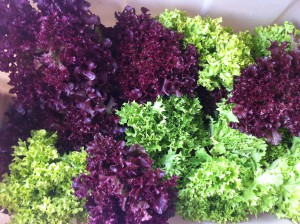
We look forward to continue our relationship with Okee’s Farm and to see what Jan (the most amazing farmer ever!) has in store for us this season( his tomatoes are to die for!!!)
We actually went over to the farm recently to check out the green house and visit all the seedlings- mainly because we love field trips, especially when they are food related.
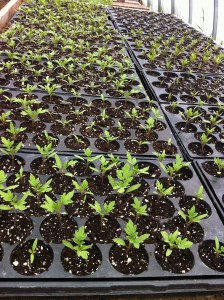
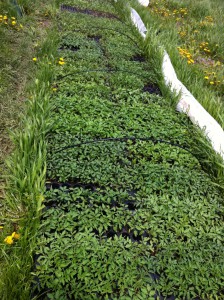
Date Added: May 28, 2013 | Comments (0) | Filed under: Living Seasonally & Locally,Shanti Kitchen
Asana of the Week with Ashtanga Yogi Mark Morra
Benefits of Uttitha Trikonansana B
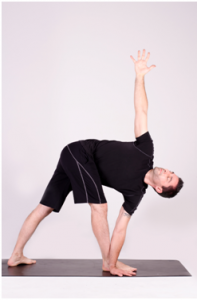
Also known as Parivrtta Trikonasana (Revolving Triangle), this pose is the counter pose of Trikonasana pose to stretch the hips and spine in opposing directions to achieve a maximum range of mobility. Some basic stretches that are occurring are: the hamstrings of the front leg, and inner thigh (semitendinosus) of the back leg; back of the front hip and front of the back hip; lower back rotators; latissimus; neck rotators. It also helps to improve digestion with the deep twist in the lower abdomen, balance by grounding through the back leg and core utilization, and strengthening of the core muscles. For best results, always do this pose with “A” version.
| Breath Count |
Breath Movement |
Body Movement |
Dristi |
Other instruction |
| Ekam (one) |
Inhale |
Step the right foot to the back of the mat, toes forward, arms raised parallel to the floor |
Nose (nasagre) |
Suck the belly in (uddiyana bandha) and breath in the upper lungs for the duration of this pose |
| Dve (two) |
Exhale |
Pivot the right foot to the back of the mat. Place the left hand down on the outside edge of the right foot, raise the right arm straight up. |
Top hand (hastagre dristi) |
- Ø State of the Asana, hold for 5 breaths
- Ø Lengthen the front leg
- Ø Square the hips to the back of the mat, and parallel to the floor
- Ø Push the top hand forward to contract core muscles and deepen twist
|
| Trini (three) |
Inhale |
Return to upright position, toes pointing forward |
Nose (nasagre) |
| Chatuari (four) |
Exhale |
Pivot the left foot to the front of the mat. Place the right hand down on the outside edge of the left foot, raise the left arm straight up. |
Top hand (hastagre dristi) |
- State of the Asana, hold for 5 breaths
- Lengthen the front leg
- Square the hips to the front of the mat, and parallel to the floor
- Push the top hand forward to contract core muscles and deepen twist
|
| Panca (five) |
Inhale |
Return to upright position, toes pointing forward |
Nose (nasagre) |
Date Added: May 27, 2013 | Comments (0) | Filed under: Living with Yoga
Asana of the week with Darin – Gomukhasana
Gomukhasana – go is the cow, and mukha is mouth or face, so this is the cow face, or the cow mouth posture. The mouth of the cow is also sometimes called the muzzle, so you can also call it the posture of the cow muzzle.

Effects and Benefits
Gomukhasana is a posture which activates the polarity of anahata chakra, and performing it will allow you to balance the heart chakra by working on its two (yin/yang – lunar/solar) aspects. When you work with anahata you are working with the energy of unconditional love, devotion, kindness, compassion, some aesthetic feelings, the sense of touch and you also have the energies of the air element.
From a physiological standpoint, gomukhasana has some specialized physiological effects. One of the most outstanding physiological effects of gomukhasana — is that it is very beneficial in healing lung diseases. It is perhaps the best asana in Yoga for healing diseases such as tuberculosis and asthma. The physiological principle is that when you perform gomukhasana first on the left side – the right lung almost stops working while the left lung is forced to work twice as hard and the opposite is true. Forcing the lungs to work in this way results in a purifying and a balancing of the lungs. This brings increased oxygen and prana to the lungs and also removes unused, stagnant air that is often lingering in the lower lobes of the lungs. Also because gomukhasana energizes the area of the heart then automatically physical healing in this area of the body is also promoted.
There are many other beneficial effects. To name just a few; there are many benefits associated with the legs and feet due to the vajrasana component. It opens the chest and increases flexibility in the upper back, and has considerable effects on the digestive system (also b/c of vajrasana component). As well, the shoulders benefit greatly from the performance of this pose – energizing and increasing flexibility in this area of the body. Since the shoulder is one of the most elaborate joints in the body and most susceptible to problems, this is a wonderful preventive asana.
Date Added: May 22, 2013 | Comments (0) | Filed under: Living with Yoga
Recipe of the Week – Halvah
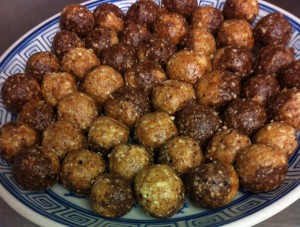 1.5 cups almonds
1.5 cups almonds1/2 cup rah tahini
3 tbsp honey
1 tsp vanilla
1 tbsp + 1 tsp carob powder
1. In a food processor, place almonds and process until finely ground.
2. Add the tahini, honey and vanilla; process thoroughly.
3. Place 1/2 the mixture into a glass baking dish or pie plate and press down flat to 1/4 inch thickness (don’t worry about filling the dish)
4. Combine remaining mixture with carob powder and process.
5. Press the carob mixture on top of the plain mixture and press together to make a 1/2 inch two-coloured slab.
6. Chill halvah in the refrigerator for 1 hour or more, then cut into bite size pieces and toll into little balls. yields 20-24 pieces.
Nomi Shannon, The Raw Gourmet
Date Added: May 1, 2013 | Comments (0) | Filed under: Shanti Kitchen














